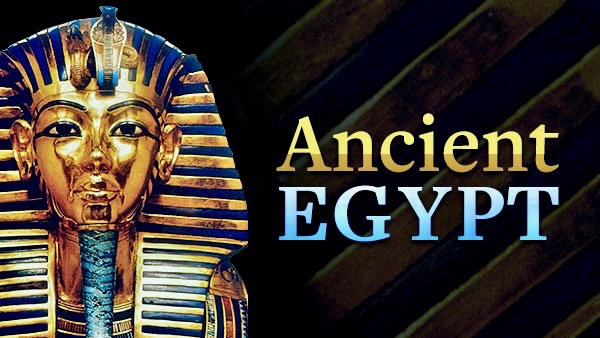“Ancient Egypt” — the phrase brings up images of sands and swords, swashbuckling Pharaohs and mysterious HUGE buildings. Clearly, the Pharaohs did have an Edifice Complex. Yet, the truth is much different — except for the big building part. Ancient Egypt was lush, green and wet from the nurturing water of the Nile. The famous Giza dessert that holds the Great Pyramids were filled back in the day with gardens and groves and waterways. Pharaohs barge is still dry docked at the Great Pyramids, even as the waterways dried up millennial ago. Egypt was the breadbasket and historically feed this entire region. For example, grain and crops from Egypt were the linchpin of the Roman economy. The Egyptian cornucopia allowed Rome to stave off defeat even though the Roman Empire inevitably went into a death spiral. Others can draw the inference of how climate change foreshadowed the end of Pharoah; and its’ lesson for us today. This article celebrates 5,000 years of glorious Egyptian history – history that can never be repeated. Posted: October, 2020.
From the great pyramids of the Old Kingdom through the military conquests of the New Kingdom, Egypt’s majesty has long entranced anyone who has cast an eye on this corner of Africa. Indeed, Ancient Egypt is part of the African experience — not the Middle East or Arab or Muslim experience, as they did not exist in those times. Note: the various lands that now constitute the Middle East existed back then and had their own rich cultures and histories. However there was no sense of the collective the “Middle East” (Arabian Peninsula, the Levant, North Africa) as we know it today. The Arabs were, well, in the Arabian Peninsula during Pharaonic times, not part of the Ancient Egyptian story. Islam started in the 6th century B.C.E., at a time when Ancient Egypt was indeed ancient history.
In Ancient Egypt there is a lot to celebrate. For almost 30 centuries—from its unification around 3100 B.C. to its conquest by Alexander the Great in 332 B.C.—ancient Egypt was the preeminent civilization and empire in the Mediterranean world. After Alexander conquered Egypt, it became basically a semi-independent province of the Greco-Roman empires. Egypt still glittered during this Greco-Roman era but the Pharaohs were the direct descendant of Alexanders general — not native Egyptians. After the death of the last Greco-Roman Pharaoh, Cleopatra, Egypt was fully absorbed into the Roman Empire as a vassel state and ruled directly by Rome.
The dynastic period started with the reign of Egypt’s first king, Narmer, in approximately 3100 BCE, and ended with the death of Cleopatra VII in 30 BCE. … After Cleopatra’s death, Egypt was absorbed by Rome, but many of the old traditions lingered …. to this day. Egypt as an independent civilization ended with Cleopatra.
Pre-Dynastic Egypt and the Creation of the Pharaonic State
Narmer = Menses = The king who first unified Egypt, The full story of Narmer (also called Menses) is lost in history. Literally, all we have is shards of pottery to guide us of his story. We know he ruled in the Early Dynastic Period circa 3100-3050 BC. In Egyptian lore, Narmer was the successor to the Protodynastic king Ka, or possibly Scorpion. The difference between the these gentlemen is that Ka and Scorpion are probably myths; whereas over time, we have established that Namer is real. For a long time, Namer has always been a near mythical figure; kind of like King Arthur in Britain. But unlike the legendary King Arthur, Narmer existence and established of dynastic Egypt was proved. The stunning proof, stunning perhaps only to archeologists or historians, was the discovery of the Palette of Narmer. This palette or emblem sets out the historic record of Narmer. This palette, supported by other evidence, moved Narmer from myth to new category: a flesh and blood King who really existed. The picture below shows the palette with highlights:
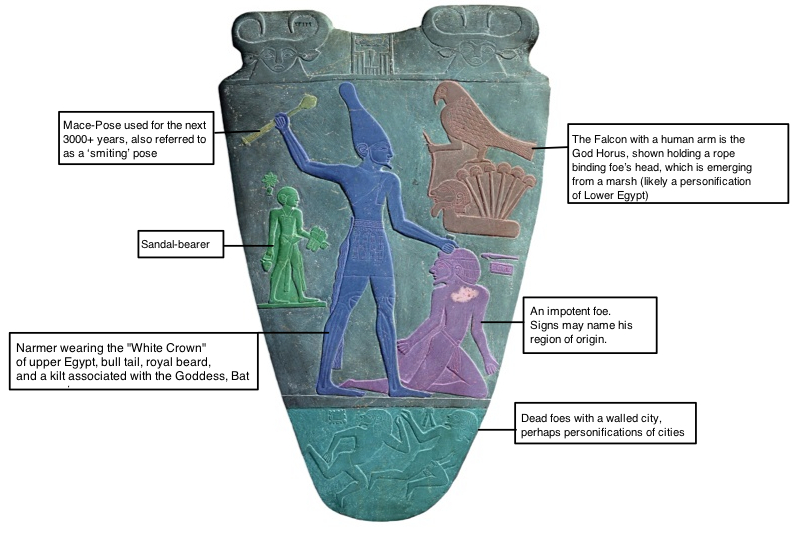
http://www.ushistory.org/civ/3c.asp
Beginning in about 4,000 B.C.E., all of Egyptian society existed in two kingdoms, Upper Egypt and Lower Egypt. Around 3,100 B.C.E., Narmer, the king of Upper Egypt conquered Lower Egypt, kicking off 3,000 years of dynastic rule. He unified the regions and built his capital city at Memphis, near the border of these two kingdoms. Because Memphis was located on an island in the Nile, it was easy to defend.
Note: Narmer is the dyastic patriarch of dynastic Egypt as he was the first ruler to unite Upper and Lower Egypt. See article entitled ____ for details on this Egyptian division. Narmer combined the white crown of Upper Egypt with the lotus symbol of Lower Egypt. Thus, Narmer was the first ruler of united Egypt.
The Three Kingdoms (Epochs) of Dynastic Egypt
Historians apply the term “kingdom” to periods of stability under successive rulers. The history of ancient Egypt is divided into three main periods: the Old Kingdom (about 2,700-2,200 B.C.E.), the Middle Kingdom (2,050-1,800 B.C.E.), and the New Kingdom (about 1,550-1,100 B.C.E.). The New Kingdom was followed by a period called the Late New Kingdom, which lasted to about 343 B.C.E.
So began the first dynasty, an age appropriately called the Early Dynastic Period. Little is known of the pharaohs (rulers) of the early dynasties. The Egyptian word “pharaoh” literally means “great house.” Only in the Third Dynasty did the ruler create the truly centralized, militarized dynastic state under the Pharaonic system. Thus with the Third Dynasty, the Old Kingdom was born and Pharaohic power was fully unfurled.
Pharaohs were more than just rulers. They were considered gods and were believed to possess the secrets of heaven and earth. Pharaohs led the government and the army and wielded unlimited power.
The Old Kingdom
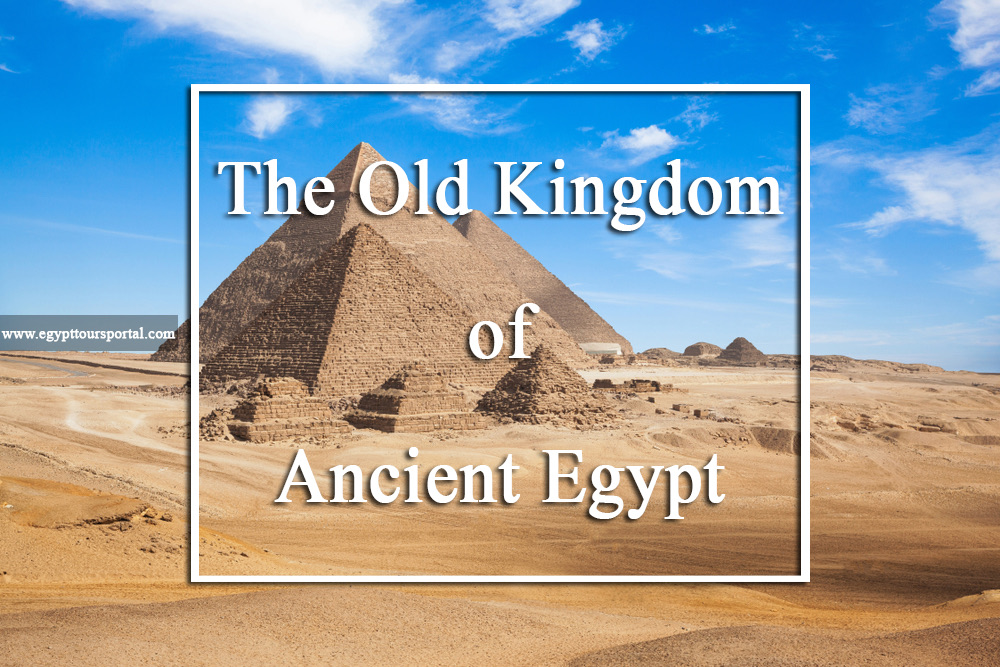
About 300 years after Menes united Egypt, its rulers formed a central government in which they held supreme power. This was the beginning of the Old Kingdom. (Kings tend to rule from a central place, which is why the early dynastic period is not considered a kingdom.)
The Old Kingdom—also referred to as the Age of the Pyramids, is most commonly regarded as spanned the Third Dynasty through to the Sixth Dynasty (2686 B.C.E.–2134 B.C.E.). The Old Kingdom was followed by a period of disunity and decline (called the First Intermediate Period), until strong central authority was restored by the Pharaohs of the Middle Kingdom. The royal capital of Egypt during the Old Kingdom was located at Memphis, where Third Dynasty Pharoah Djoser established his Palace. Djoser also built the first monumental pyramid — the Step Pyramid of Djoser in Saqqara, Memphis. The step pyramid of Djoser in Saqqara believed to have been the first pyramid constructed in Egypt, was completed in the 27th century B.C.E. during the Third Dynasty. Pyramid building progressed through the dynasties, culminating in the Pyramids of Giza).
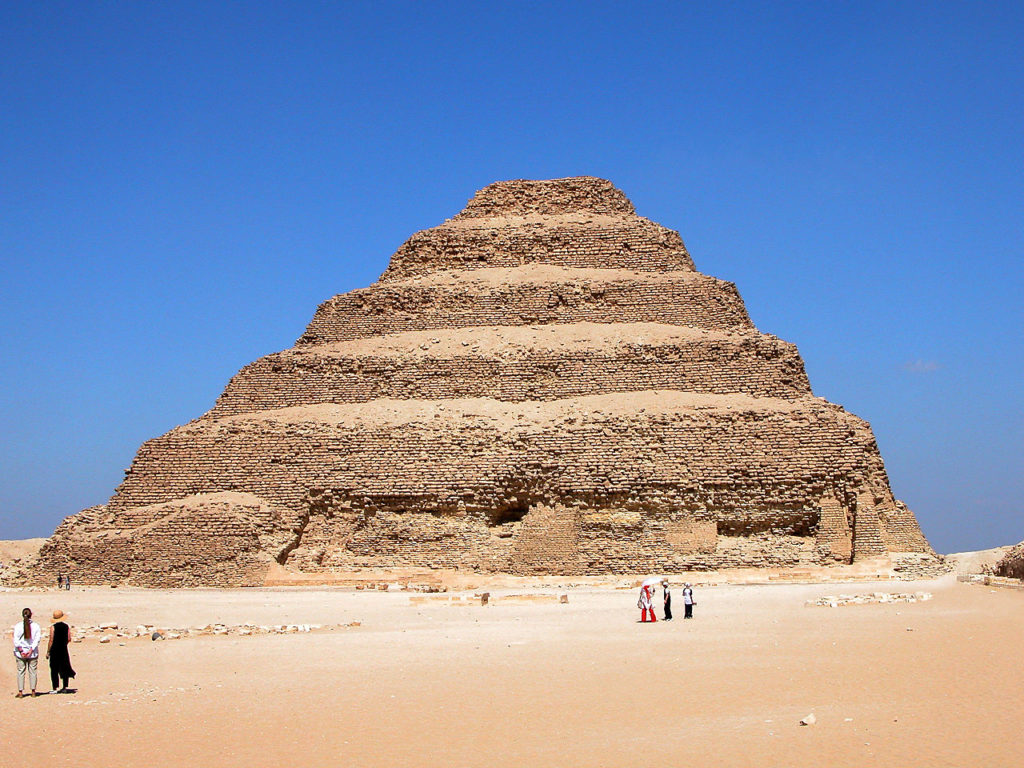
This early pyramid, built in step segments, layed the foundation for the expansion of pyramids under Djoser’s successors. Thus, the Djoser pyramids were followed by the Great Pyramids of Giza. The most well known of these monuments, such as the Sphinx and monumental Khufu Pyramid, were built during this period of pyramid expansion. Third Dynasty Pharaoh Khufu (also known by his Greek name, Cheops) had the six-million-ton Great Pyramid of Giza constructed as his tomb. Under Chephren, a Fourth Dynasty ruler, the Great Sphinx was built.
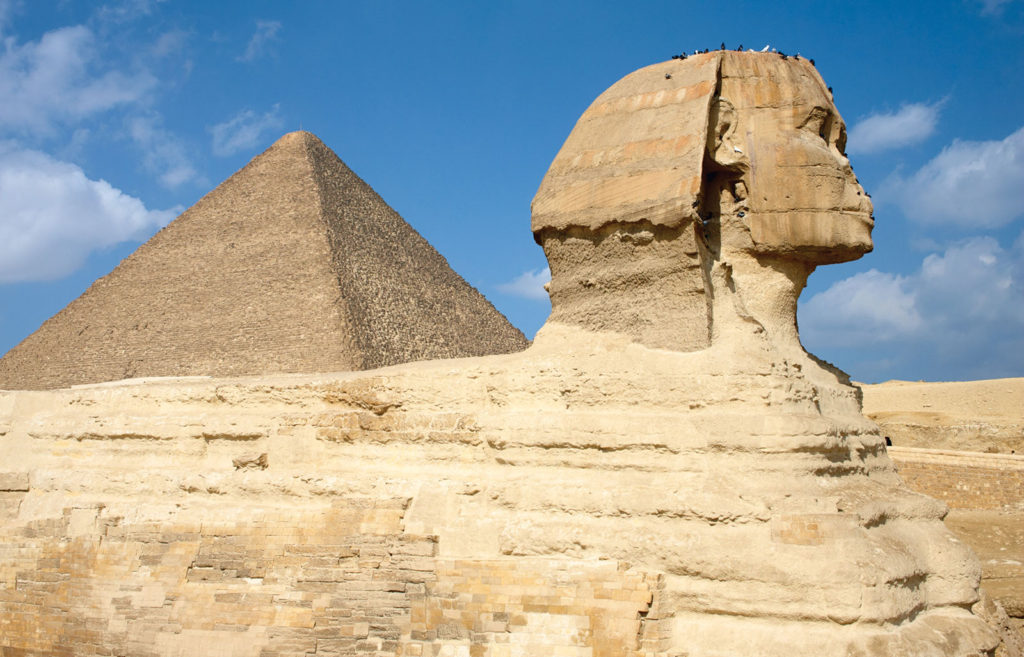
In total, the Great Pyramids consists of the three main, most famous pyramids, and several smaller pyramids for the wives of the pharaohs and other small outcrop buildings, plus the dock for the royal barge Way back when, the pyramid area was green, lush and the Nile meandered nearby. Note: the Nile River route has changed considerably over time.

The end of the Old Kingdom was marked by civil wars between pharaohs and nobles. The zenith of Pharaohs power was accompanied by the belief in the Pharaoh’s divinity and infallibility. This absolutism was balanced by the concept of Maat (daughter of Ra, goddess of truth and justice), justice or order, which was the baliwick of the priests and championed by nobles. Maat through the priesthood had the responsibility to uphold justice and order. Thus, the nobles in reliance (or alliance) with the priesthood, effectively curbed excesses of Pharaohs otherwise almost absolute power. This counterbalance became a much stronger aspect of the Egyptian social system after the collapse of the Old Kingdom, when was interpreted as a failure of Pharaonic moral behavior. Thus, ascription of divinity to the king strengthened his ability to unify the kingdom; while the Priesthoods ascription of an even higher order of divinity to “morality’ made him accountable for his actions.
The Middle Kingdom
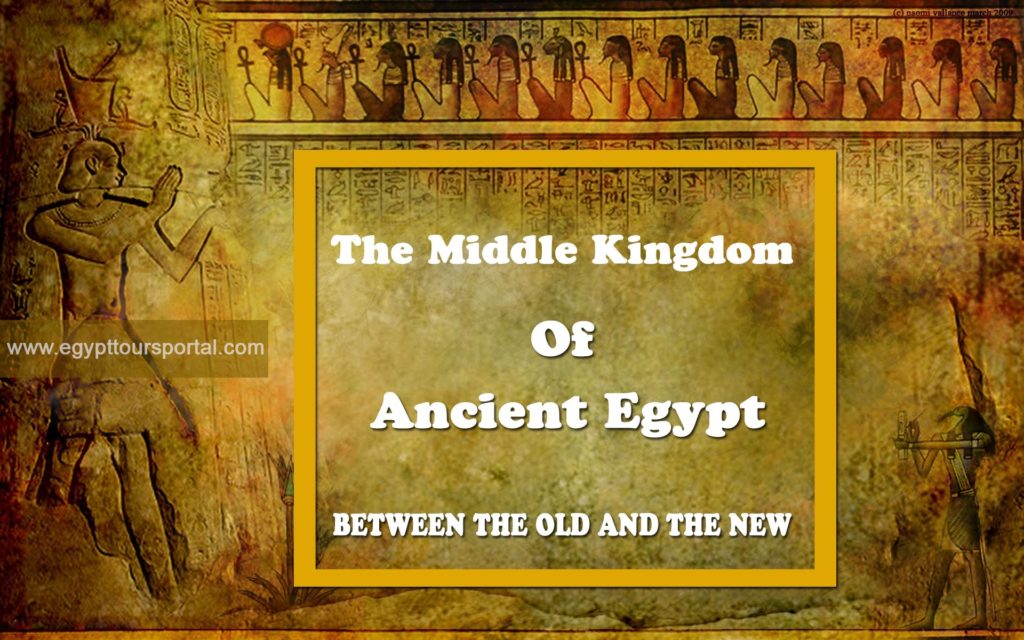
Montuhotep II (2,007-1,956 B.C.E.), an Eleventh dynasty pharaoh, was the last ruler of the Old Kingdom and the first ruler of the Middle Kingdom. He and his successors restored political order.
The Middle Kingdom is remembered as a time of flourishing arts, particularly in jewelry making. Egypt became a great trading power during this period and continued massive construction projects. Eventually, the long reign of prosperity gave way to old problems: crop failures, economic woes, dynastic power struggles, and foreign invaders.
One of the most renowned Middle Kingdom pharaohs was Amenemhet III (1817-1772 B.C.E.), of the Twelfth Dynasty. He was responsible for the construction of two great projects. He completed the building of the giant waterwheels of the Faiyum region that diverted the floodwaters of the Nile. Amenemhet also constructed the Pyramid of Hawara, which became known as the Labyrinth. It contained about 3,000 rooms. Ironically, this pyramid is largely ignored by tourists now. The Romans removed all the outside casement (facade covering) and it looks like a big pile of rubble. The labyrinth, recently re-discovered after being lost for a millenium, is off limits to tourists. Even the the burial chamber which leads to the labyrinth is often rightly described as a technical marvel. The entire burial chamber is carved from a single piece of hard quartzite into a rectangular chamber to hold all the caskets and extensive funerary objects. After all the burials had been completed; the chamber was sealed by a single roofing slab of some 45 tons.
The Pyramid of Hawara was the most visited sites of the ancient World – not the Great Pyramids of Giza nor the Sphinx. Herodotus claimed to have counted three thousand rooms in the pyramids funeral complex during the 5th century BC. From the mouth of Herodotus himself: This I have actually seen, a work beyond words. For if anyone put together the buildings of the Greeks and display of their labours, they would seem lesser in both effort and expense to this labyrinth… Even the pyramids are beyond words, and each was equal to many and mighty works of the Greeks. Yet the labyrinth surpasses even the pyramids. Herodotus (‘Histories’, Book, II, 148). Herodotus historic writing often contained real “whoppers” (tall tales either exaggerated or doubtful). For Millenium, the labyrinth was thought to be a myth or a real structure destroyed by the Ptolemaic Kings (the foreign Pharaohs from the Greco-Roman period after Alexander’s conquest of Egypt).
In 2008, the temple’s underground funeral labyrinth was discovered and is being explored by high tech sensors as we speak. Here are the drawings rendered from this stunning research:
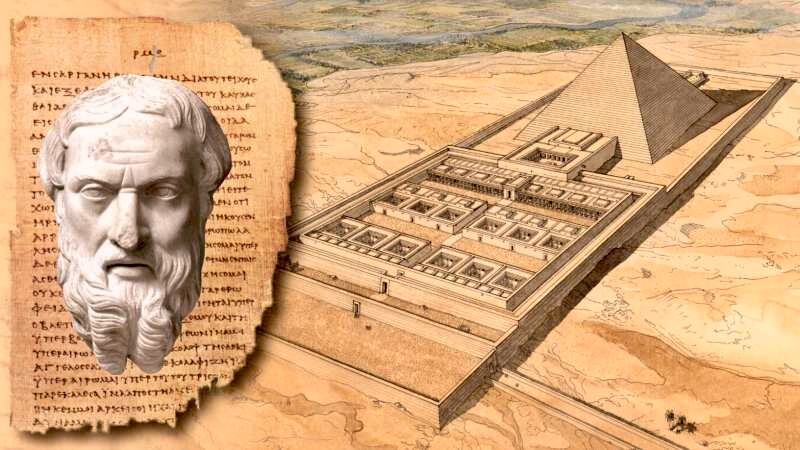
Trouble struck when a group of foreigners, the Hyksos, a Semitic-Asiatic group, invaded the Nile Delta region. These advanced warriors used new tools for war: bronze weapons and horse-drawn chariots. They defeated the Egyptians, who fought on foot with copper-and-stone weapons. The Middle Kingdom was over.
The New Kingdom

New Kingdom (c. 1567-1085 B.C.)
Early pharaohs of the New Kingdom evicted the Hyksos. The New Kingdom is remembered as a time of renaissance in artistic creation, but also as the end of dynastic rule. This period was also marred by corrupt priests and tomb-robbing by government officials.
Under Ahmose I, the first king of the 18th dynasty, Egypt was once again reunited. During the 18th dynasty, Egypt restored its control over Nubia and began military campaigns in Palestine, clashing with other powers in the area such as the Mitannians and the Hittites. The country went on to establish the world’s first great empire, stretching from Nubia to the Euphrates River in Asia. In addition to powerful kings such as Amenhotep I (1546-1526 B.C.), Thutmose I (1525-1512 B.C.) and Amenhotep III (1417-1379 B.C.), the New Kingdom was notable for the role of royal women such as Queen Hatshepsut (1503-1482 B.C.), who began ruling as a regent for her young stepson (he later became Thutmose III, Egypt’s greatest military hero), but rose to wield all the powers of a pharaoh.
A famed pharaoh of the new period was Amenhotep IV, who triggered a religious revolution. Before Amenhotep’s rule, Egypt was a polytheistic society that believed in many gods, the most important named Amon. But, Amenhotep believed only in Aton, the sun god. Belief in only one god (monotheism) was a radical notion. To show his devotion to Aton, the pharaoh changed his name to Akenhaton (“he who is loyal to Aton”). Akenhaton moved his capital from Thebes, where Amon was worshipped, to Tell el Amarna.
Naturally, the priests who represented the other gods did not like this change one bit. Many Egyptians also did not like the pharaoh discrediting their gods. After the death of Akenhaton, the powerful priests forced the new capital to be moved back to Thebes .
Tut-Tut
Tutankhamun, the son and successor to Akenhaton,, may be the most famous of Egypt’s pharaohs because of the discovery of his untouched tomb in 1922. The tombs of more prominent pharaohs had been pillaged, but Tutankhamun’s resting place and its golden treasures had escaped the hands of looters. This most famous tomb was discovered by Harold Carter in 1922 in the most serendipitous way on November 4, 1922 the very last day of digging. Everyone expected that when the five o’clock work whistle blew, (imagery), on November 4, the workers would pack up and break camp: the project was a failure. All they found in the sand was more and more sand. But at 2:00 pm, Carter and his crew hit pay dirt — the entrance to the staircase leading down to the tomb of King Tutankhamen. The rest is history.
Tutankhamun’s real role in history’s was that of the boy-king who moved the capital back to Thebes. He ruled for nine years, and spent a lot of his attention trying attempted to pacify contumacious, priests threatening to revolt. Tutankhamun was also responsible for some modest building projects. He began his reign in 1333 B.C.E. at the age of ten but died of a head injury at nineteen in 1323 B.C.E..
Ramses II, or Ramses the Great, was another important ruler during this period. He reigned for 67 years and died in about 1,213 B.C.E. at age 96. His nearly 200 wives and concubines bore 96 sons and 60 daughters. Not only did Ramesses build a great family, he also built two temples at Abu Simbel, a covered hall of giant pillars at Karnak, additions at the Luxor Temple, and the Ramesseum, a compound consisting of two temples and a palace. After Ramses’ rule, Egypt fell into steady decline.
After the New Kingdom – A Nine Hundred Year Decline into Chaos and Confusion
Over the course of the next nine centuries, the Nubians, the Assyrians, and the Persians bounded into Egypt and ravaged the area. When Pharaoh Nectanebo II retreated to Memphis to avoid death at the hands of oncoming Persian invaders in 343 B.C.E., he became the last Egyptian-born pharaoh, ending over 2,500 years of Egyptian self-rule.
Enter Alexander and Egypt Becomes a Greco or Ptolemaic State
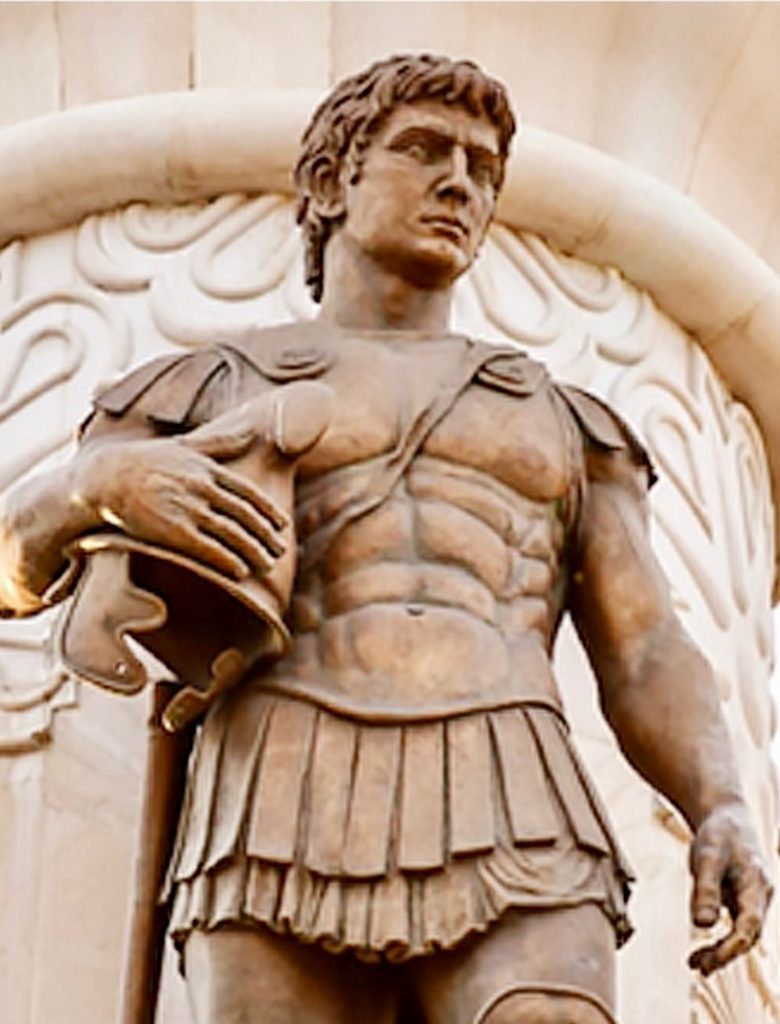
Alexander the Great was a Greek conqueror from Macedonia. In 331, Alexander marched into Egypt after defeating Darius for control of Syria and the Levant. At the time, Egypt was a loosely held vassel state of the Persian Empire. Yet, Egypt had a lot of independence under this arrangement. The Egyptians resented the Persians and welcomed the Greek army. Oracle of Amun at Siwa Oasis pronounced Alexander as the new ‘master of the universe’ and a descendent of the Egyptian god Amun. Alexander the Great had himself proclaimed pharaoh. He assumed the double crown symbolizing Upper and Lower Egypt; thus, adopting the traditional royal title and emoluments of the pharaohs. Alexander only spent four months total in Egypt. He was busy — on to conquer the Persians!
One of the open secrets to Alexander’s success is that he respected Egypt culture and tried to enhance its founding traditions. At the same time, he installed a Greek government under the control of his army to administer his new province, Egypt. Alexander took other steps to cement Egypt into his empire: including bringing in many Greek immigrants and founding whole new Hellenistic cities. For example, Alexander also founded a new Egyptian capital, Alexandria, at the mouth of the Nile. This city was located on the Mediterranean — just across the Mediterranean pond from Greece itself
Although Alexander would never return to Egypt, dying in Babylon in 323 BCE, the Greek rule that he established endured. In the crisis after Alexander’s death, Ptolomy, one of his generals, claimed Egypt as his kingdom. Ptolemy became Pharaoh and established hereditary rule. The Ptolomaic Dynasty would last for three hundred years until the Romans conquered Egypt in 32 BC. In the fatal year of 32 BCE, Egypt falls to the armies of Roman general Octavius. Egypt then becomes a Roman Province never to re-emerge as an independent state until modern times. Hence, the time period from 323 BCE onward is also called the Greco-Roman Period, which covers the Ptolemaic dynasty and subsequent Roman rule.
Cleopatra: Egypt’s Finale as an Independent State
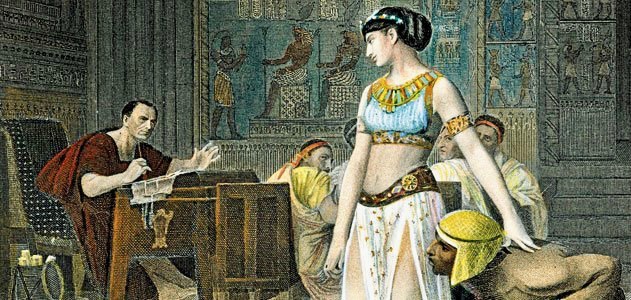
Cleopatra in Greek means “Famous in Her Father” and perhaps show the subordination of women as a reflection of the family patriarch. The plural “woman” is used in the last sentence as the famous Cleopatra we all know, was actually Cleopatra the Seventh (Cleopatra VII). Our Cleopatra was born 70/69 BCE—died August 30 BCE, Alexandria. She was a direct descendant of its founder Ptolemy I, the founder of the Greco-Egytian state three hundred years earlier. Ptolemy I was a Macedonian Greek general and companion of Alexander the Great who inherentes Egypt upon the death of Alexander. Ceopatra was the last Egyptian queen, famous in history and drama as the lover of Julius Caesar and later as the wife of Mark Anthony When her father Ptolemy XII died in 51 BC, Cleopatra became co-regent with her 10-year-old brother Ptolemy XIII. They were married, in keeping with Egyptian tradition. … In 47 BC, Cleopatra bore Caesar a child – Caesarion – though Caesar never publicly acknowledged him as his son. Later, Cleopatra switched allegiances and aligned with Mark Anthony. After the assignation of Caesar, Mark Anthony and Cleopatra squared off against Octavian (the future Caesar Augustus) for the control of the Roman Empire— it was a battle royale . After the Roman armies of Octavian defeated Anthony and Cleopatra’s combined forces, they both committed suicide, and Egypt fell under Roman domination.
Here is an understatement from Wikipedia: “Cleopatra actively influenced Roman politics at a crucial period, and she came to represent, as did no other woman of antiquity, the prototype of the romantic femme fatale.”
